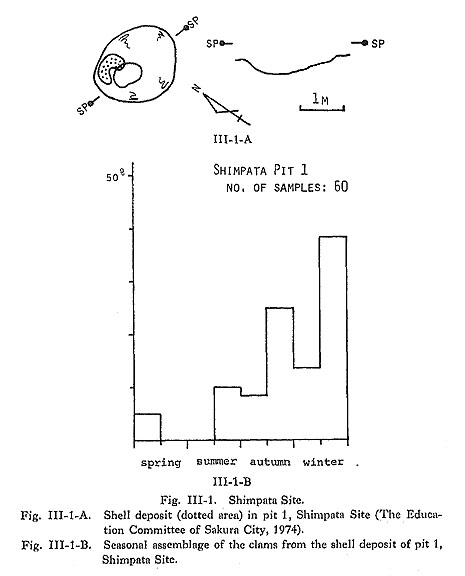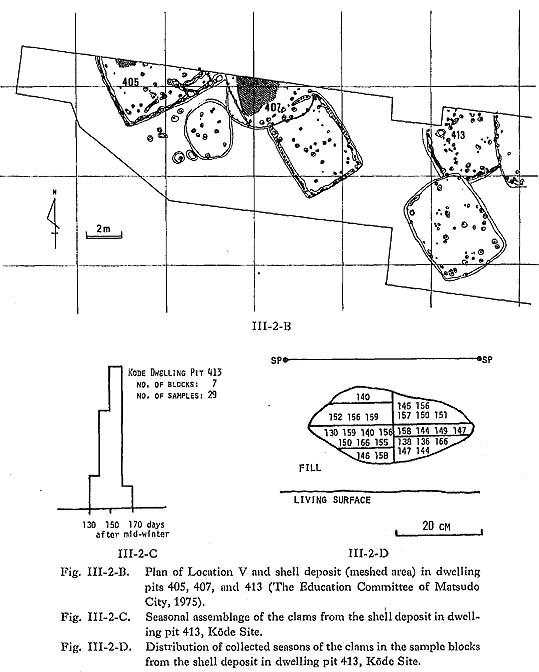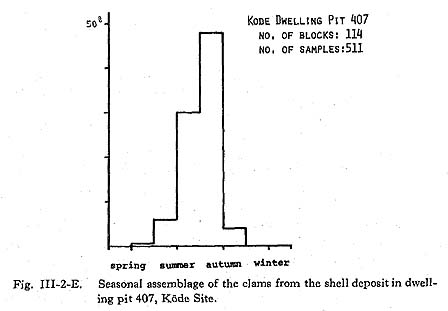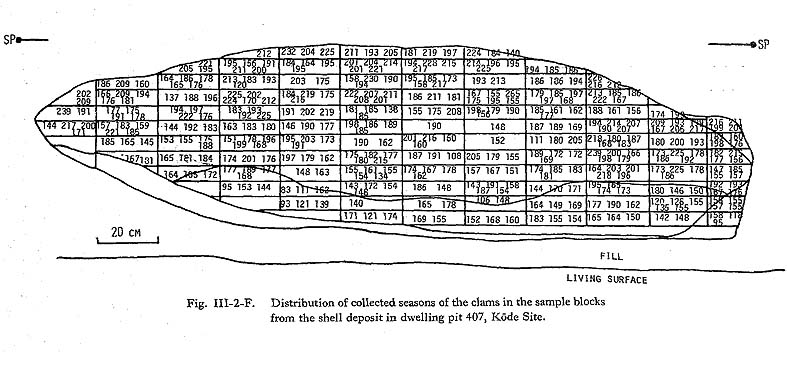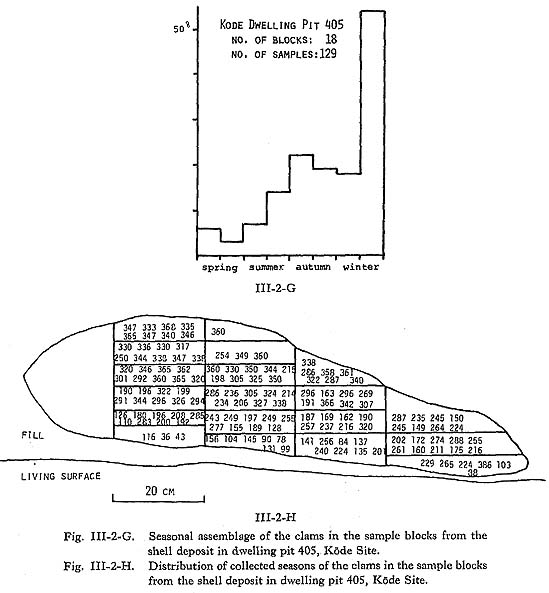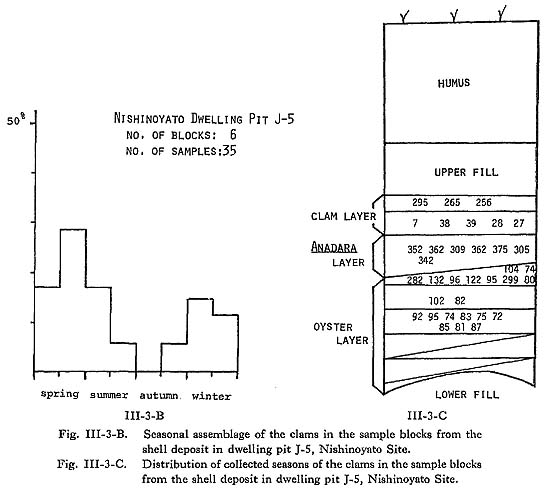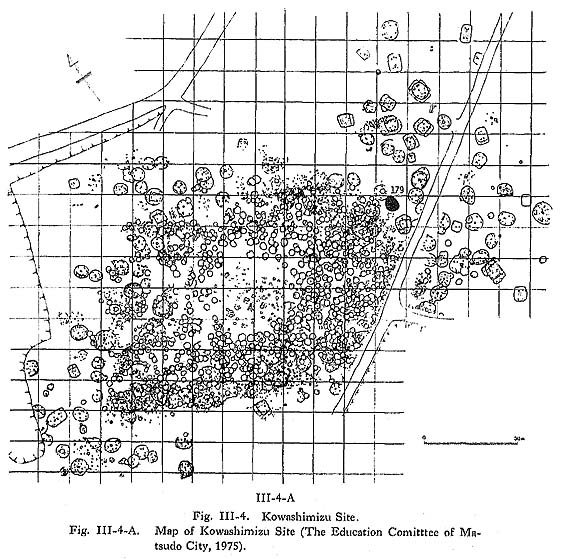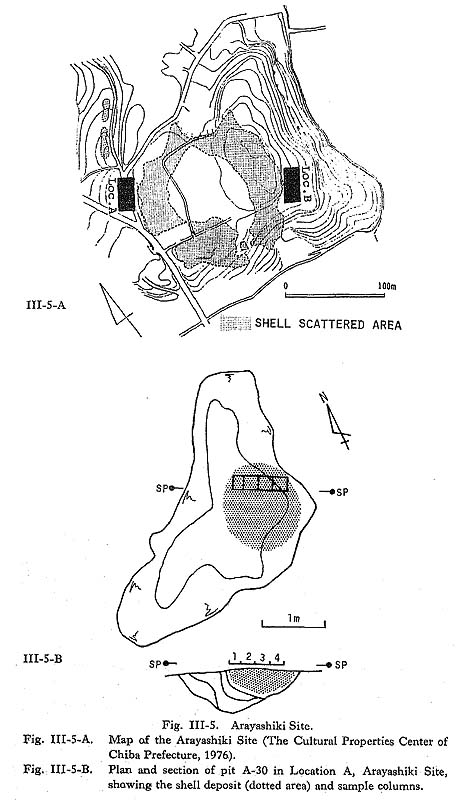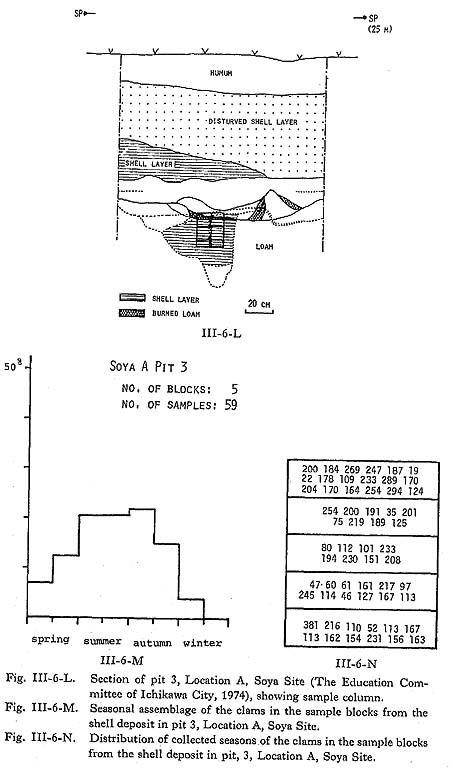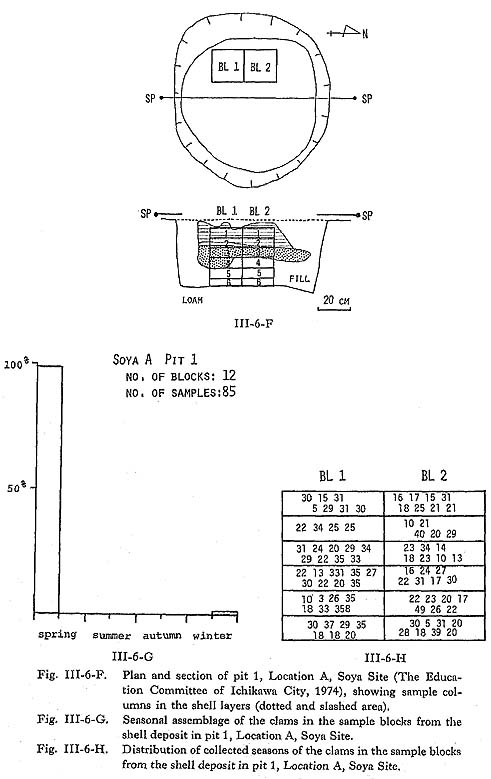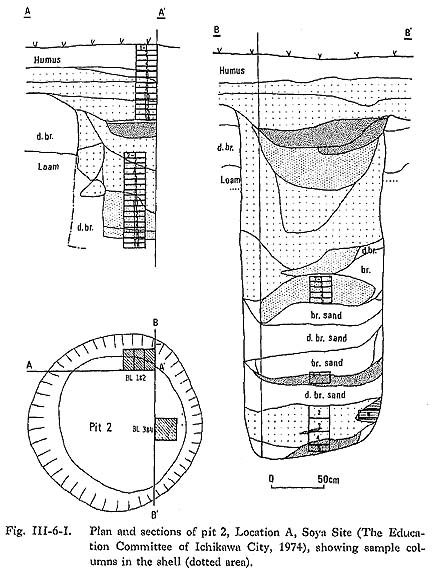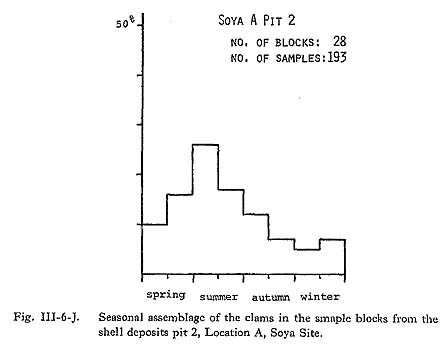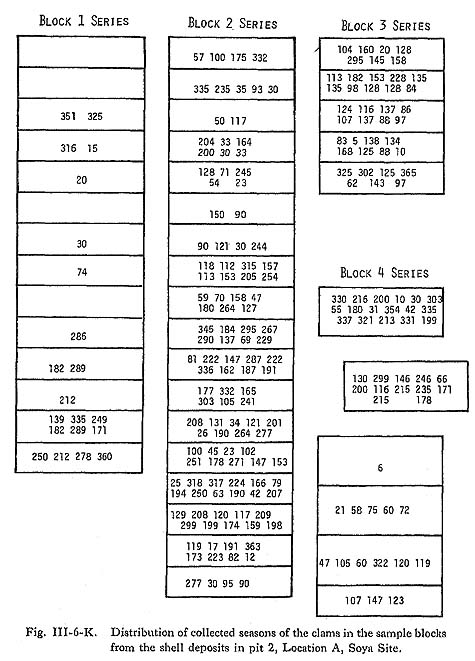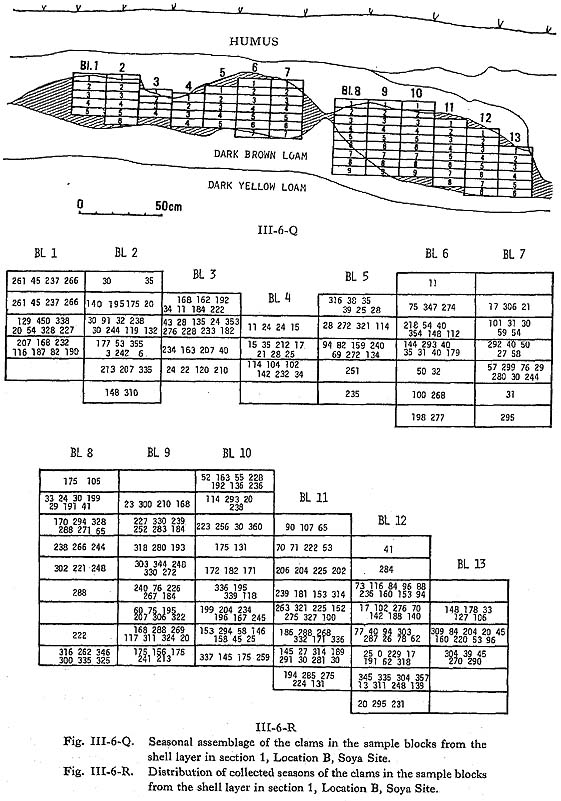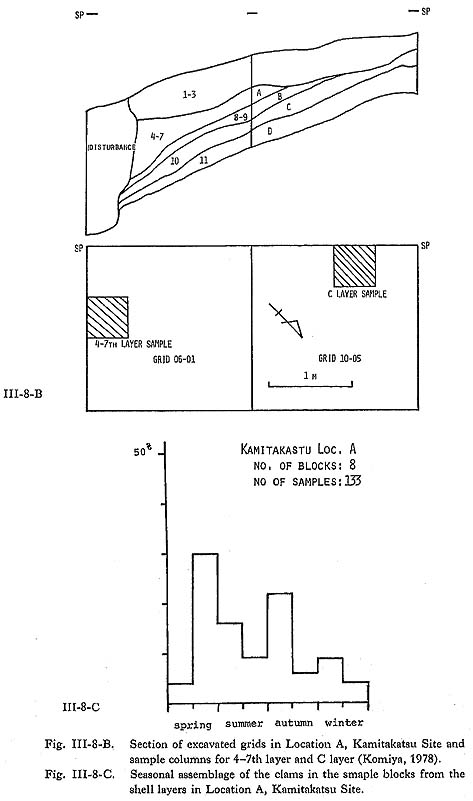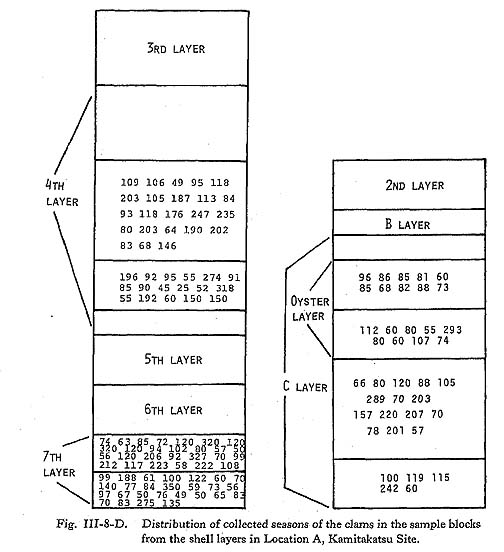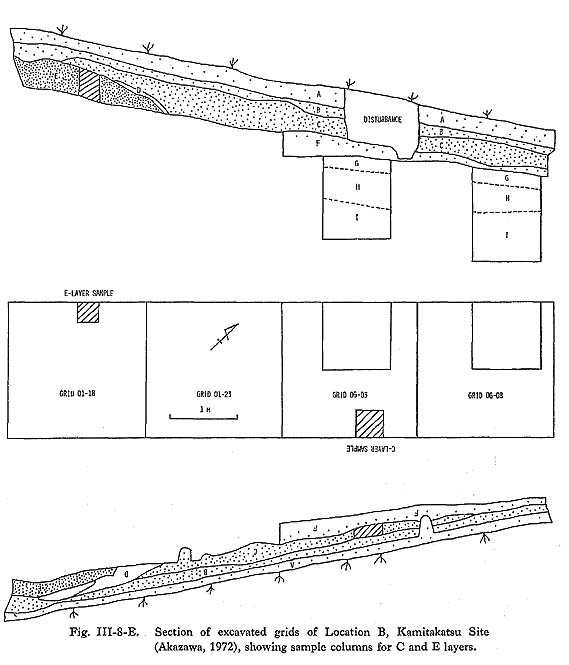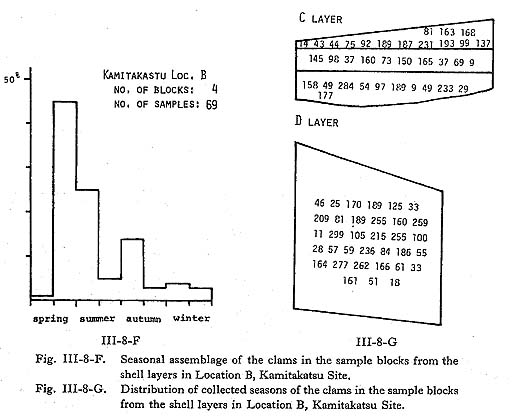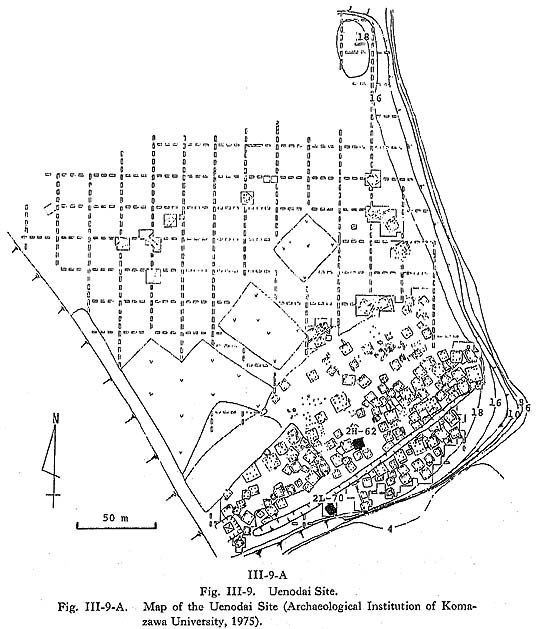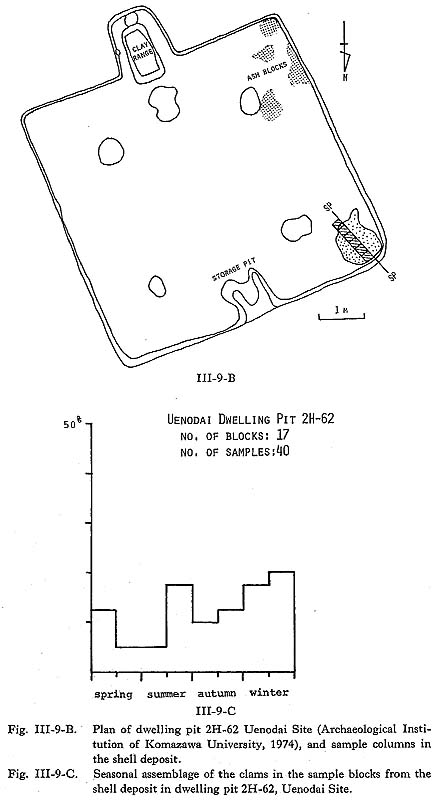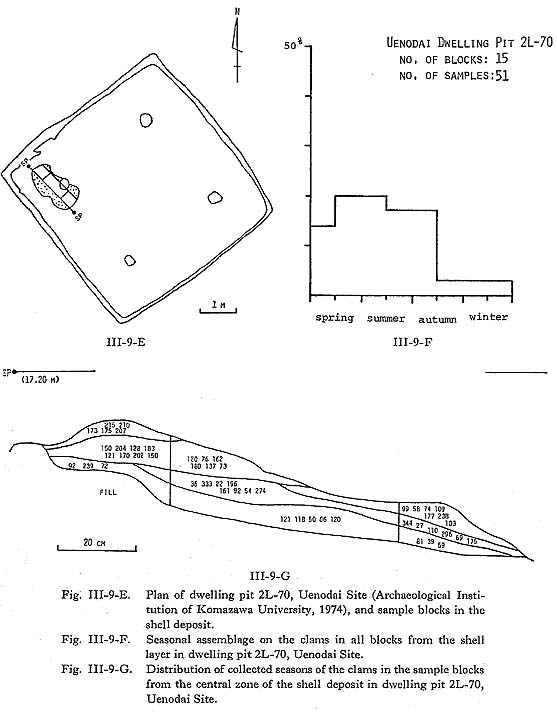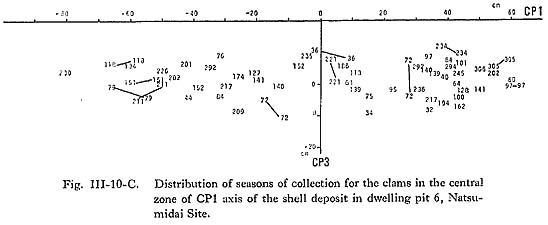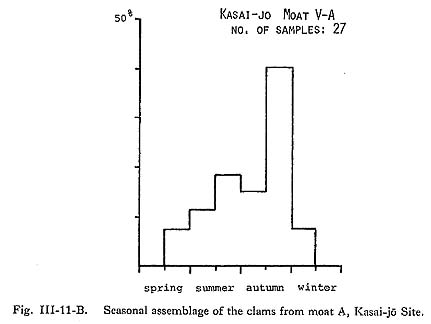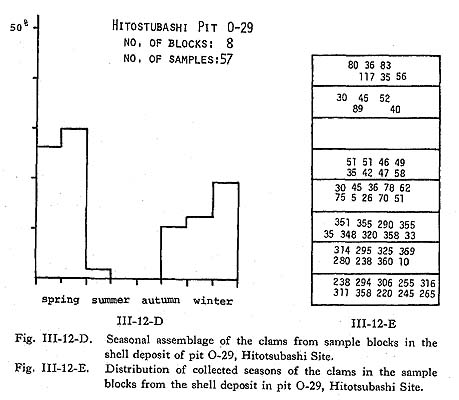PART II. SEASONALITY OF SHELL-COLLECTING
ACTIVITIES IN PREHISTORIC JAPAN
III. Description of Sites and Analytical Results
III-1. Shimpata SiteThe Shimpata Site is located at Shimpata, I-ju, Sakura City, Chiba Prefecture in the Kanto District (140°12'E, 35°43'N), about 1.5 km south from Imba Lake. The site is situated on the southern fringe of a terrace (28 m above sea level) facing a branch valley (about 8 m) of the Kashima River which flows into Imba Lake, which is believed to have been a lagoon during the Jomon transgression. Excavation of the site was carried out by the Education Committee of Sakura City (1974), and 2 dwelling pits and 4 storage pits accompanied by Kayama-type pottery of the late phase of the Earliest Jomon period were excavated within a 1,500 m2 area. Shell Deposit of Pit 1A well-preserved shell deposit (Fig. III-1-A) was found in the upper fill of pit 1 (about 2.2 m long and 40 cm depth), and the whole deposit was sampled and submitted to the author (Koike, 1974c). The shell assemblage consists mainly of species common to inner-bay tidal flats: Anadara (Tegillarca) granosa (56.9%), Crassostrea gigas (31.7%), Meretrix lusoria (4.0%), and others. Seasonality: The seasonal composition of the 60 analyzed clams from. the pit 1 (Fig. III-1-B) showed an almost complete one-year cycle, except for late spring and early summer, with a peak in early winter.
III-2. Kode SiteThe Kode Site (Fig. III-2-A) is located at Kode, Matsudo City, Chiba Prefecture (139°55'E, 35°51'N), about 20 km up the Edo River from Tokyo Bay. The site is situated on a peninsula-like terrace extending from the Shimousa Hills. The bluff is surrounded by the alluvial flats of the Edo River on the west and a branch valley on the east. The surface of the terrace is 19.5 m above sea level; the alluvial flat is about 6 m above the sea level, and is estimated to have been under sea water during the Jomon transgression. The site spreads across a tongue-shaped bluff along the western edge of the terrace. Clusters of shells dot the bluff over an area 250 m to the north and south and 180 m to the east and west. Fragments of Jomon pottery found on the surface with the shells are mainly of the Selkiyama type, belonging to the early phase of the Early Jomon period. Excavation of the site was begun in 1970 by the Education Committee of Matsudo City. In 1975 work was carried out on Location V (Fig. III-2-B) on the western edge of the site, and 12 dwelling pits accompanied by Sekiyama-type pottery were excavated within a 350 m2 area (Education Committee of Matsudo City, 1975).
Shell Deposit of Dwelling Pit 413Dwelling pit 413 (Fig. III-2-B) was rectangular, about 6.3 m long, with fragments of Sekiyama-type pottery in the fill of the pit. On the well-preserved living surface, 4 deposits of shells were found. Shells in 3 of these were partly burned and badly pre-served. The remaining shell deposit (about 40 cm in diameter with a maximum thick-ness of 20 cm) was unbroken and well preserved. Block samples for analysis were taken along the central section of the shell deposit. The shells remaining outside the block samples were collected after screening through a 1 cm mesh. Seasonality: The clams from. the 6 block samples (Fig. III-2-C) were all harvested in the late summer, ranging form the 130th day to the 170th day after the annual growth minimum. The average was 153 days, with a standard deviation of 8 days which is considered to be within the range of the probable counting error for the seasonal dating techniques. The distribution of seasonally dated clams (Fig. III-2-D) was also homogeneous. The shells in this layer are thought to have been abandoned within a single season, and the shell layer to consist of a single unit of disposal. Shell Deposit of Dwelling Pit 407Dwelling pit 407 (Fig. III-2-B) is believed to be a pair of overlapping dwelling plans, consisting of dwelling pits 407A and 407B. Pit 407B was square, with a central fireplace from which fragments of Sekiyama-type pottery were excavated. The fill layer was thin and mixed with crushed shell fragments. The floor of pit 407A was constructed by pasting loam on top of the broken shells in pit 407B, and the fireplace was found below a layer of badly burned and crushed shells. A moderate number of large Sekiyama-type pottery fragments were placed directly on this upper living surface. The shell in the fill layer was a maximum of 70 cm thick and 240 cm in diameter. The shell layer contained little soil or artifacts. Shell assemblage consisted mainly of Meretrix lusoria, though the number of Crassosterea gigas and Anadara (Tegillarca) granosa shells increased in the lower part of the deposit. Block samples for analysis, 20 cm × 20 cm × 5 cm per unit, were taken along the section in the north side of the dwelling (Fig. III-2-B). Seasonality: The seasonal composition of the clams of the 114 block samples from this shell deposit (Fig. III-2-E) emphasized late summer to early autumn gathering, ranging from the 70th to the 270th day after the annual growth minimum. The seasonal stratification of the shell deposit (Fig. III-2-F) is as follows: a few clams dated as having been collected in summer were found at the bottom of the layer. The middle part of the layer was filled with clams that had been taken in late summer and early autumn, and those that had been harvested in late autumn were found on the upper surface. Thus, a seasonal sequence from early summer to late autumn was recognized in the shell deposit.
Shell Deposit of Dwelling Pit 405The plan of dwelling pit 405 (Fig. III-2-B) was inferred to be rectangular and 6.3 m long. Shells were accompanied by fragments of Sekiyama-type pottery. A well-pre- served shell deposit was found in the northern section of the dwelling pit. The shells were almost directly on the living surface, and bones of Sus scrofa and Cervus nippon were found in the bottom of the deposit.
Seasonality: The seasonal composition of the clam in the 19 block samples from dwelling pit 405 (Fig. III-2-G) ranged throughout the year. There was a sharp peak in the late winter, and collection was relatively active during autumn and winter. The distribution of seasonally dated clams in the shell deposit (Fig. III-2-H) indicated that the seasonal stratification changed in parallel with the inclination of the shell deposit. Clams deposited in the upper part had been collected in the late winter, those in the middle part had been collected during the autumn and early winter, and those at the bottom of the western blocks had been collected in the spring and early summer. There fore, the clams in this shell deposit possibly come from a one-year sequence of deposition which began in the early spring at the bottom, went on from summer to autumn in the middle, and ended in the late winter at the surface of the shell deposit.
III-3. Nishinoyato Site
The Nishinoyato site is located at Nishinoyato, Kohoku-ku, Yokohama City, Kanagawa Prefecture in the Kanto District (139°36' E, 35°33' N), about 10 km up the Tama River from Tokyo Bay. The site lies on a long terrace (about 40 m above sea level) facing a rice field (about 10 m) in the north and east.
Excavation of the site was carried out in 1973 by the Education Committee of Yokohama City (1973), and 14 dwelling pits and 15 other pits accompanied mainly by Moroiso A type pottery of the late phase of the Early Jomon period were excavated within a 1,300 m2 area. Shell deposits were found in the 4 dwelling pits, and one of these was sampled by blocks and used for the analysis.
Shell Deposit of Dwelling Pit J-5
The dwelling plan of J-5 (Fig. III-3-A) was rectangular (7 m by 6 m), accompanied by Moroiso A type pottery. The shell deposit (3.3 m by 2.3 m) was found in the northern half of the dwelling pit, resting on a dark brown silt loam layer of the fill. Although the central part of the shell deposit had already been disturbed, at the site of the sample block it was divided into 3 parts by the shell assemblage composition: the upper layer (8 cm thick) consisted mainly of Meretrix lusoria, Anadara (Tegillarca) grwwsa and Mactra veneriformis, the middle layer (6-8 cm thick) mainly of A. granosa and a few of M. lusoria, and the lower layer (18-25 cm thick) filled with Crassostrea gigas accompanied by M. lusoria, especially in the upper half.
Seasonality: The seasonal composition of the clam in the 6 block samples from the shell deposit of dwelling pit J-5 (Fig. III-3-B) had two peaks in late spring and in early winter. The distribution of seasons in the sample blocks (Fig. III-3-C) is as follows: Clams in the upper clam layer had been collected in the late autumn to early winter, and those in the lower clam layer had been collected in the early spring. Clams in the Anadara-layer had been collected in winter. The oyster layer was filled with clams dated in the late spring to early summer, although a few of the clams dated to early winter. Thus clams in the sample blocks of the shell deposit showed specific seasons in each layer as divided by the shell assemblage composition.
III-4. Kowashimizu SiteThe Kowashimizu Site (Fig. III-4-A) is located at Kowashimizu, Higurashi, Matsudo City, Chiba Prefecture (139°57' E, 35°47' N), about 12 km up the Edo River from Tokyo Bay. The site lies on a peninsula-like terrace of 27 m above sea level, and its relative height above the surrounding rice fields is about 20 m. The site is about 150 m north-south and 200 m east-west. Pottery sherds found in the site ranged from the Katsuzaka and Otamadai types to the Kasori E type, belonging to the Middle Jomon period.
Excavation of the site started in 1971 and ended in 1975, and was conducted by the Education Committee of Matsudo City (1975); 231 dwelling pits and 1,031 storage pits were excavated from an area of 23,500m2 covering almost the entire occupation area. Three dwelling pits were accompanied by shell deposits in their fills, and one of them was sampled for analysis. Shell Deposit of Dwelling Pit 179Dwelling pit 179 (Fig. III-4-B) located at the western fringe of the dwelling circles, had an elliptical plan (5.2 m by 4.1 m). The shell deposit rested on a dark brown silty loam layer constituting the lower fill of the dwelling pit. At the base of the shell deposit, large fragments of Kasori E II-type pottery from the late phase of the Middle Jomon period were found. Most of the shell deposit seemed to be porous and partly disturbed. Clear stratification was observed only in the northern section, which was divided into an upper and a lower layer by an intermediate soil layer. The upper shell layer consisted mainly of Umbonium (Suchium) moniliferum, and the lower layer consisted of Tapes (Ruditapes) japonica and Meretrix lusoria.
Seasonality: The 39 block samples taken from the shell deposit in dwelling pit 179 (Fig. III-4-C) contained shells from all seasons of the year, showing two peaks of late spring and late winter. The distribution of seasonally dated clams (Fig. III-4-D) showed that clams taken from sample blocks 1 to 4 and 13 to 15 consisted of a relatively wide range of seasons. A few clams dated as being from late summer were found in blocks11 and 12, from the base of the central part of the shell deposit. In the remaining part of blocks 5 to 10, seasonal stratification was detectable as follows: the clams that had been collected in the late spring were mainly distributed in the upper blocks; the clams that had been collected during the winter were generally found in the middle blocks, and the lower blocks were filled with clams that had been collected in the late autumn and winter.
These results suggest that seasonal dating will be useful in distinguishing a primary deposition from a disturbed one, as was the case in the southern part of this shell deposit. The primary deposition in the northern part of the shell deposit was accumulated during the late spring season in the upper layer and during the late autumn to winter in the lower layer. III-5. Arayashiki SiteThe Arayashiki site (Fig. III-5-A) is located at Kaizuka-cho, Chiba City, Chiba Prefecture (140°09' E, 35°37'N), about 3.5 km up the Eshizu River from Tokyo Bay. The site lies on a terrace 28 m above sea level, and its average height above the wet rice field is about 19 m. Shell spreads cover an area 150 m to the north and south and 160 m to the east and south. Fragments of Jomon pottery are mainly of the Otamadai and Kasori E types of the later half of the Middle Jomon period.
Excavation of the site was carried out in 1975 by the Cultural Properties Center of Chiba Prefecture (1976) at Locations A (1,512 m2) and B (576m2), situated at the out skirts of the site. Shell Deposit of Pit A-30A highly concentrated shell deposit (Fig. III-5-B) was found in the eastern part of the upper fill of pit A-30 (4.6 m wide in long axis and 65 cm deep from the loam surface), accompanied by fragments of Kasori E II-type pottery. Shell assemblage consisted mainly of Meretrix lusoria, Umbonium (Suchium) moniliferum, and Tapes (Rudi-tapes) japonicus. Block sampling was carried out along the central section of the pit covering the whole shell deposit (Koike, 1974d). Seasonality: The seasonal composition of the clam in the 17 block samples (Fig. III-5-C) contained almost each season for a full year range from late spring to winter, with a sharp peak in summer. The distribution of seasonally dated clams (Fig. III-5-D) indicated that the seasonal sequence was hardly detectable, although clams collected in summer were concentrated in the central part, and clams collected in autumn were scattered on the fringes of the deposit. A relatively wide range of seasons in each sample block could be caused by an inadequate sampling technique: the bottom of the shell deposit was conical-shape, and clams of different seasonal strata might be sampled together in a block.
III-6. Soya SiteThe Soya Site is located at Soya, Ichikawa City, Chiba Prefecture (139°56' E, 35°44'N), about 10 km up the Edo River from Tokyo Bay. The site is situated on a peninsula like terrace (25 m above sea level), and faces west toward the Kokubu branch valley. The floor of this valley is only about 5 m above sea level and is believed to have been under sea water during the Jomon transgression. The Soya shellmound (Fig. III-6-A) is 200m east-west and 240m north-south; it is recognized as the largest shellmound in Japan. Shells on the surface of the field along the upper fringe of the bluff are 22-25 m above sea level. The concentration forms a slight hollow, opening to the north. Chronologically, it spans a period from the later phase of the Middle Jomon period to the beginning of the Latest Jomon period; its most intensive use was during the Late Jomon.
The site was extensively excavated during the summer seasons of 1974, 1975, 1976 and 1977 by the Education Committee of Ichikawa City (1975). In 1974, Locations A (70m2) and B (60m2) were excavated; Location A (Fig. III-6-B) is situated in the south central part of the shellmound, and Location B (Fig. III-6-N) is located at the southern edge of the shell.concentration.
The Shell Layers along Section A at Location ASection A along the central east-west section (Fig. III-6-C) was divided into 5 stratigraphic layers. The humus layer was generally 20-30 cm thick and had been heavily cultivated. Under the humus layer, a low-concentration shell layer (shell layer I) was found extending over the entire excavation area. The fragments of pottery found in this layer were mainly the Horinouchi type belonging to the early stage of the Late Jomon period. The percentage of unbroken shells was higher than in the humus layer. Shell layer II, of somewhat greater concentration, was accompanied by potsherds belonging to the Shomyoji type (the earliest phase of Late Jomon) and the Kasori E type (the latest phase of Middle Jomon). A considerable amount of animal bones and fish remains was excavated from this layer. The composition of the shell assemblage varied from place to place.
Beneath the shell layers, a dark brown layer of silty loam, accompanied by potsherds of the Shomyoji and Kasori E types, was found. Then the color of the soil changed to light brown or yellowish brown, and the soil facies became clayish and homogeneous, blending into loam. These layers were occasionally disturbed by pits dug from the shell layers. Seasonality: The A-7 series covered Shell Layer I (blocks A-7-1 to A-7-5) and Shell Layer II (blocks A-7-6 to A-7-9). The 1st series taken from the upper part of pit No. 2 covered the humus layer (blocks 1-1 to 1-5) and Shell Layer I (blocks 1-6 to 1-10). The seasonal composition of the clams in 14 block samples from the shell layers along section A (Fig. III-6-D) encompassed seasons throughout the year, with emphasis on spring and early summer. Distribution of seasonally dated clams sampled from section A are illustrated in Fig. III-6-E. The shells in Shell Layer I of the A-7 series indicated collection throughout the year, while the shells in Shell Layer II were restricted to spring and summer. In the humus layer of the 8th series, the collection of clams had been restricted to early spring. Clams from Shell Layer I had been collected during late autumn and winter. It is interesting to note that the seasonality of the humus layer in the 8th series is relatively simple, in spite of an apparently disturbed layer due to cultivation. Hence, it is suspected that this layer might have been disturbed rather recently and that it was originally composed of short seasonalities, similar to the shell layers of I and II Section A. Shell Deposit of Pit 1 at Location APit 1 (Fig. III-6-F) was a 100 cm-wide rib-shaped pit. The pit appeared to have been dug from the dark brown layer, and its original depth might have been 80 cm, although the depth from the loam surface was about 40 cm. Hence, the shell layer was deposited on a dark brown soil of the fill and was about 20 cm thick in the central section and about 30 cm thick at its sides. The shell layer was subdivided into 2 strata: The upper stratum was composed mainly of Meretrix lusoria, and the lower stratum. also included Crassostrea gigas and Mactra veneriformis.
Seasonality: The seasonal composition of the clams in 12 block samples from the shell deposit of pit 1 (Fig. III-6-G) was restricted to the early spring, except for one specimen dated as being from late winter. Although the shell deposits have been divided into two parts according to the composition of shell assemblage, the seasonal distributions (Fig. III-6-H) are similar for these two samples, both estimated as 20±8 days after the annual growth minimum. These results show that the deposition of the shell layer took place too rapidly to be subdivided into seasonal layers by this method. Shell Deposit to Pit 2, Location APit 2 (Fig. III-6-I) was a deep cylindrical pit, 130 cm in diameter, 380 cm deep from the field surface, and 330 cm deep from the loam surface. The wall of the pit was smooth and vertical, and the bottom was smooth and almost flat. Block sampling in 4 columns was carried out on the southern section wall for the upper fill shell layers (block series 1 and 2), and on the western section wall for the shell layer of the lower fill (block series 3 and 4).
The first column (block series 1) covered the humus layer (blocks 1-1 to 1-5), the Vertically deposited shell layers of the site itself (blocks 1-6 to 1-10), and the upper most fill of the pit (blocks 1-11 to 1-14). These first 2 layers were considered similar depositions as the layers observed along section A accompanied by potsheds of the Horinouchi II type. The second column (block series 2) was located in the loose shell layer (blocks 2-1 to 2-8) and the slightly more concentrated shell layer (blocks 2-9 to 2-18). These shell layers contained charcoal and fragments of pottery, ranging back in time from the Horinouchi I and Shomyoji types to the Kasori E III type. The third column (block series 3) was situated in a highly concentrated shell layer about 30 cm thick. The shells were seldom broken, suggesting that this was a primary deposition. Under the shell layer three fresh sandy layers were alternately laid, and these sandy layers contained few artifacts. Block series 4 was taken from 4 shell layers: a 6-cm-thick layer between sandy layer (block 4-1), a loose shell layer about 25 cm thick (blocks 4-2 to 4-4), a lowermost and densest shell layer (block 4-5), and a shell deposit on the northern fringe of the loose shell layer (block 4-6). The thin shell layer of block 4-1 was accompanied by a certain amount of charcoal and a few fragments of Kasori E III-type pottery. In the highly concentrated shell layer of block 4-6, Umbonium (Suchium) moniliferum was dominant. The shell layer composed mainly of U. (S.) moniliferum (block 4-5) sat directly on the loam surface at the bottom of the pit. Seasonality: The seasonal composition of the clams in 28 block samples from the shell deposit of pit 2 (Fig. III-6-J) showed a full one-year seasonal variety, having a peak in early summer. The distribution of the seasonally dated clams in the block samples is illustrated in Fig. III-6-K. The results on the humus and shell layer I (blocks 1-1 to 1-10) have already been described in section A. Clams from the uppermost fill of the pit (blocks 1-11 to 1-14) were collected mainly during autumn and winter. Clams from the second upper fill (block series 2) showed a full range of seasonal variations. The clams in block series 3 consisted mainly of shells which had been collected in late spring and early summer. In block series 4, clams from block 4-1 had been collected throughout the year, while those from block 4-6 had mainly been gathered during autumn, and those from blocks 4-2 to 4-5 had been collected during spring and early summer.
Summing up these results, the upper fill consisted of clams collected throughout the year, while clams found in the lower fill showed specific seasons in each layer. This suggests that the lower fill deposits were made relatively rapidly, and that each was followed by a peiod of disuse of the pit which allowed the accumulation of a sandy layer. Thus alternate sandy layers and highly concentrated shell layers were built up. After the lower half of the pit was filled, the deposition of the pit proceeded rather slowly, or consisted of secondary concentration, overflowing from neighboring deposits. Shell Deposit of Pit 3, Location ABeneath a fireplace surrounded by burnt loam, a shell deposit was found in a conical-shaped pit registered as pit 3 (Fig. III-6-L). The upper fill was accompanied by fragments of Kasori E III-type pottery from the latest phase of Middle Jomon. The shell concentration in the pit was relatively high; however, the shell layer was loosely and homogeneously mixed with the soil. Seasonality: Seasonal composition of the clams in the 5 block samples from the shell deposit of Pit 3 (Fig. III-6-M) showed that the clams which had been collected in all seasons during the year except for late winter. The distribution of seasonally dated clams (Fig. III-6-N) was also homogeneous, with a wide variety of seasons in each block. These results suggest that this layer may be a secondary deposit. Additionally, loam clods observed on the upper fill around the shell deposit were considered to be the same as the loam of a fireplace. This shell deposit was made with soil from a neighboring shell deposit to fill the pit at the time when the fireplace was made. Shell Layer of Section 1, Location BLocation B (Fig. III-6-O) is situated on the southern edge of the shellmound. Observation of section 1 (Fig. III-6-P) along its eastern grid wall revealed that the upper part of the shell layer had been disturbed by cultivation and that pits had been dug into it. The boundary from the disturbed layer, however, was rather clearly distinguished. Block sampling was carried out only for the undisturbed part of the shell layer. The shell assemblage in the shell layer was not homogeneous, and clusters of Rapana venosa were observed in the southern grids. However, stratification was not so clear as to enable subdivision by composition of shell assemblage.
Seasonality: The clam in the 87 block samples from the shell layer of section 1 (Fig. III-6-Q) were taken in every season of the year, with a slightly larger number taken in early spring than in other seasons. The distribution of seasonally dated clams (Fig. III-6-R) was such as to place a wide variety of seasons in each block. Close observation revealed that some block samples had a specific season: clams from the upper surface (block samples 2-1, 4-1, 5-1, 6-1, 11-1 to 2, 12-3, and 3-2) had mainly been collected in spring, and those collected in winter were found near the bottom of the central part (block sample 8-9).
III-7. Miyamotodai SiteThe Miyamotodai Site (Fig. III-7-A) is located at Miyamoto-cho, Funabashi City, Chiba Prefecture (140°00'E, 35°48'N), about 1.5km up the Ebi River from Tokyo Bay. The site is situated on a long terrace 22 m above sea level, facing wet rice fields in the north from which its relative height is about 13 m. Shell concentrations 5-10 m in diameter are dotted on an area of 130 m north-south and 200 m east-west. Fragments of Jomon pottery belonging to the Late Jomon period were found on the surface.
Excavation of the site was carried out in 1969 by the Education Committee of Funabashi City (1974); 6 dwelling pits, 17 pits accompanied by human bones of 30 individuals were found in a 4,400 m2 area. Shell Deposits of Grids 1-11-C, 2-10-C, 4-2-C, and 5-28-BHighly concentrated shell deposits were found in grids 1-11-C, 2-10-C, 4-2-C, and 5-28-B (Fig. III-7-A). The shell deposit at grid 1-11-C was a relatively low-concentrated shell layer sitting on the burnt loam. whicli was thought to be the fill of a burnt dwelling pit. The shell deposit at grid 2-10-C was a highly concentrated shell layer and was also estimated to be a part of the fill of a dwelling pit. The remaining shell deposits seemed to be the upper fill of pits; the plan of the pits was confirmed after shell layers were dug up to the loam surface. Each pack of samples for these shell deposits was sampled by the excavator and submitted to the author (Koike, 1974a). Seasonality: The seasonal composition of the clams in sample blocks from the shell deposit at grids 1-11-C, 2-19-C, 4-2-C, and 5-28-B (Fig. III-7-B) showed that 2 former shell layers had clams that had been collected during each seasons of the year, and the remaining 3 shell deposits had a peculiar seasonality, with a peak in early spring.
Shell Deposit of Pit 1-2Pit 1-2 (1.2 m in diameter 1 m deep) had 7 shell deposits of the 1st-7th layers (Fig. III-7-C). The 1st and 2nd layers were characterized by broken clams and bad preservation. The 3rd layer was a relatively highly concentrated shell layer consisting of Meretrix lusoria, Mactra veneriformis, and Cyclina orientalis. The 4th layer was an intermediated soil layer accompanied by Shomyoji-type pottery of the earliest phase of the Late Jomon period. The 5th layer was a relatively highly concentrated shell layer consisting of almost the same shell assemblage as the 3rd layer. The 6th layer sat directly on the bottom of the pit and was a highly concentrated shell layer consisting almost entirely of a single species of M. lusoria. The 7th layer sat on the 6th layer in the corner of the pit, and consisted mainly of Umborium (Suchium) moniliferum. Each pack of samples of these shell layers was collected by the excavator and submitted to the author. Seasonality: The seasonal composition of the clams of 7 samples from the shell deposit of pit 1-2 (Fig. III-7-D) consisted of each season of the year, with 2 peaks for early spring and late summer / early autumn. The distribution of seasonally dated clams (Fig. III-7-E) indicated that clams from the 1st to 5th layers had been collected in the early spring. The 6th layer contained clams collected in summer and partly in early autumn. Clams in the 7th layer had been collected in early autumn (2 individuals) and early spring (1 individual). These results show that the shell deposit in this pit consisted of 2 seasonal strata: the 1st to 5th layers of the early spring season and the 6th to 7th layers of the late summer to early autumn season.
III-8. Kamitakatsu SiteThe Kamitakatsu Site (Fig. III-8-A) is located at Kamitakatsu, Tsuchiura City, Ibaragi Prefecture, in the Kanto District (140°12' E, 36°04' N). The site is situated on the western bank of the Sakura River, about 7 km upstream from Kasumigaura Lake. The site lies on a terrace 22 m above sea level and is slanted eastward opening toward the river. The site consists of 5 concentrations of scattered shells on the edge of the plateau, distributed in an area 140 m by 120 m.
The site was excavated in 1969 by the Department of Anthropology, the University of Tokyo (Akazawa, 1972), and also in 1970 by the Archaeological Institute, Keio University. Shell Layers of the Excavated Grids at Location AIn the center of Location A, two excavation grids, each 2 m by 2 m, were set up as grids 06-01 and 10-05 (Fig. III-8-B). The humus layer (the 1st to 3rd layers), or a disturbance layer due to cultivation, was a maximum of 50 cm thick. Shell layers (the 4th to 10th layers) lay on a steep slope of about 20 degrees inclination, and were subdivided according to the concentration of shells. The shell layers of the 4th to 7th layers contained Kasori B type pottery from the middle phase of Late Jomon, and had a high concentration of Corbicula (Corbicula) japonica. The 8th and 9th layers had relatively low concentration of shells, but the 10th or C layer had a high concentration of shells. In the upper part of the C layer, a spot of Crassostrea gigas was found. These layers yielded Kasori B and Horinouchi-type pottery from the early and middle phase of the Late Jomon period. The 11th layer was a dark-brownish silty layer accompanied only by fragments of shells.
Seasonality: The seasonal composition of the clams of 8 block samples from the shell layers in Location A (Fig. III-8-C) consisted of each season of the year, having 2 peaks in late spring and in early autumn. The distribution of seasonally dated clams (Fig. III-8-D) indicated that the 4th, 7th, and C layers contained clams collected in each season of the year. In the block sample of the oyster layer, however, all the clams except one specimen were dated from the late spring to the early summer. Thus, the specific stratigraphy by collection season of the clam agreed well with the distinctive shell assemblage of the oyster layer.
Shell Layers of the Excavated Grids at Location BOn the northeastern fringe of Location B, 4 grids 2 m by 2 m were set up as grids 01-18, 01-23, 06-03 and 06-08 (Fig. III-8-E). Layers A and B were humus layers resulting from cultivation. Layer C was about 40 cm thick. The shell concentration in layer C was relatively high, consisting mainly of Corbicula (Corbicula) japonica, including Meretrix lusoria and Rapana venosa. Layer D was a rather thin and consisted of pure clay. Under the clay, a relatively clear stratification consisting of large fragments of potsheds and bones was observed. Layer E was 20-40 cm thick, but it was found only in the northern grids. The concentration of shells was highest in the excavated layers. Pottery sherds mainly consisted of the Angyo I and II types from the late phase of the Late Jomon period. Well-preserved mammalian and fish bones were found in layers C and E.
Seasonality: The seasonal composition of the clams of 4 block samples from the shell layers in location B (Fig. III-8-F) also showed a full one-year cycle, having 2 peaks in late spring and in early autumn. It is interesting that the seasonal composition of the clams in each block sample from both C and D layers in Location B and from the 4th, 7th, and C layers in Location A of this site show a similar pattern. The general pattern of seasonal composition in this site was as follows: the clams dated from. late spring to early summer accounted for over 50% of the total specimens analyzed. The percentage decreased in late summer but increased in early autumn. A few of the clams were collected from late autumn to early spring.
The distribution of the seasonally dated clams in the sample blocks (Fig. III-8-G) was homogeneous, suggesting that these shell layers are naturally-formed reworked deposits: they sit on a slope of the embankment along the terrace. III-9. Uenodai SiteThe Uenodai Site is located at Uenodai, Makuhari-cho, Chiba City, Chiba Prefecture (140°03' E, 35°39' N). The site is situated about 1 km north of Tokyo Bay, on the Uenodai Terrace facing toward the bay. Its altitude is 15-18 m above sea level, and its relative height above the alluvial plain is about 12-13 m. The site was excavated in 1973 and 1974 under the sponsorship of the Education Committee of Chiba City. The eastern part of the site (Location D) was investigated by the Archaeological Laboratory of Komazawa University. At location D (Fig. III-9-A), 209 dwelling pits accompanied by Onitaka-type pottery of the Late Kofun period, 3 dwelling pits accompanied by Izumi-type pottery of the Middle Kofun period, and a few dwelling pits of the Yayoi period were found (Jishage, 1975). Several dwelling pits contained shell deposits in their fills, and 2 of these shell deposits were sampled and used for seasonal dating analysis.
Shell Deposit of Dwelling Pit 2H-62Dwelling pit 2H-62 (Fig. III-9-B) was 6.5 m square with an oven made of loam in the center of the southwest wall. Unbroken Onitaka-type pottery was found on the living surface of the dwelling pit. A shell deposit (a maximum of 150 cm long and 20 cm thick) was found in the western corner of the dwelling pit. It lay almost directly on the living surface, however, an edge of the shell deposit sat on a fill of dark-brownsilt, indicating that the shell deposit was formed after the soil had already covered the abandoned dwelling wall. The middle of the thickest part of the deposit contained little soil, and the percentage of shells decreased towards the fringe of the shell deposit.
Seasonality: The seasonal composition of the clams of 17 block samples from the shell deposit of dwelling pit 2H-62 (Fig. III-9-C) showed that it contained each season of the year, having a weak drop in late spring to early summer. The collection seasons were scattered throughout the shell deposit (Fig. III-9-D). Close observation of the western corner, the thicker part of the shell deposit, revealed that clams deposited at the upper part had mainly been collected in the late summer; those collected in winter were found at the middle part of the deposit. A few of the clams dated from early spring were found at the bottom in the western blocks. In the blocks distant from the western corner, the thinner part of the shell deposit, clear seasonal stratification was not found, suggesting that the fringe of the shell deposit was a reworked deposit.
Shell Deposit of Dwelling Pit 2L-70Dwelling pit 2L-70 (Fig. III-9-E) was 4.5 m square with Onitaka-type pottery in its fill. A shell deposit 20 cm thick was found in the western corner of the dwelling pit. It laid on the fill of dark brown silt. The shell deposit was divided into 4 layers according to the concentration of shells; the 1st layer was of low-shell-concentration with bad preservation. The 2nd and 3rd layers were of relatively high-shell-concentration and were divided by a layer of large pottery fragments. The 4th layer was again of low-shell-concentration.
Seasonality: The seasonal composition of the clams of 15 block samples from the shell deposit of dwelling pit 2L-70 (Fig. III-9-F) consisted mainly of seasons from spring to early autumn. This shell deposit (Fig. III-9-G) had a tendency such that clams deposited at the upper layer had been collected in late summer to early autumn, those of the middle part had been collected in summer, and those in the lower part had been collected in late spring to early summer. It was difficult to find a clear seasonal stratification on the fringes of the shell deposit. III-10. Natsumidai SiteThe Natsumidai Site is located at Natsumi-cho, Funabashi City, Chiba Prefecture (139°59' E, 35°43' N). The site is situated about 3 km up from Tokyo Bay, on a terrace projecting towards the bay. The site was excavated in 1974 by the Education Committee of Funabashi City (1974), and 13 dwelling pits were found in a 2,066 m2 area. These dwelling pits all yielded Onitaka-type pottery belonging to the Late Kofun period. Shell Deposit of Dwelling Pit 6Dwelling pit 6 (Fig. III-10-A) was 7.8 m square. In the northern corner, a shell deposit 180 cm long, 80 cm wide, and 30 cm thick was situated on the dark brownish loam of the fill of the dwelling pit. The artifacts and shells within the shell deposit were excavated three-dimensionally, and a total of 4,382 shells, 22 pieces of Onitaka-type pottery, and one unfinished stone ornament were recorded in this way (Koike, 1974b). Valve-pairing carried out on the clams (Koike, 1975a) indicated that the distance separating the valves of each pair can give some knowledge of the degree of the movement of shells: The modal distance of separation was found to be 4-6 cm, with 70% of the pairs separated by 20 cm or less. The lines connecting pairs viewed in cross-section showed considerable movement parallel to the slope of shell deposit; vertical movement was less evident than horizontal movement.
Seasonality: The seasonal dating technique showed that clams in the shell deposit had been collected throughout the year (Fig. III-10-B). The seasonal composition had a sharp peak in late spring to early summer, accounting for 48% of the total specimens analyzed. There were very few clams collected during winter. The distribution of the collection seasons of clams within ± 5 cm from the central long axis (CP1 axis) showed that migrations of shells in the shell deposit viewed by lines connecting pairs in the cross-section would affect the investigation of seasonal sequence. When the collection seasons of the clams were plotted in cross-section (Fig. III-10-C), a seasonal sequence could not be clearly observed. Close observation suggested that clams deposited at the bottom of the deposit tended to have been collected from spring and early summer. Clams in the middle part had been collected mostly during summer and autumn, and those gathered in spring appeared in the upper surface of the shell layer.
Thus, the shells in this dwelling pit seem to represent more than a one-year sequential disposal; the first and second spring disposals were separated by the regression plane of the late summer-late winter disposal. A statistical treatment was then carried out: the results of principal component analysis (Koike, 1979) showed that the mean depth of each season's deposit changed roughly with the calendar, moving from about -30 cm for the first early spring to about -16 cm for the second late spring, and could be subdivided into three main seasonal strata: lower stratum from the first early spring to early summer, middle stratum from the late summer to late winter, and upper stratum from the second early spring to early summer. Although some inversions were observed between summer and autumn and also between the second spring and early summer, these could be considered to be within the limits of the movement of shells. The long axes of each season also were scarcely changed in orientation and declination, suggesting that shells were thrown into the pit from the same direction during the course of several seasons, increasing only the thickness of the accumulation. Based on these results, the shell deposit is thought to have been continuously used as a disposal place. III-11. Kasai-jo SiteThe Kasai-jo Site is located at Aoto, Katsushika-ku, Tokyo Metropolis, in the Kanto District (139°52' E, 35°45' N). The site is situated on the alluvial plain (less than 1 m above sea level) of the Arakawa River, 12 km up from Tokyo Bay. Excavation of the site was carried out in 1972-1976 by the Education Committee of the Tokyo Metropolitan Government (1977). Moats and wells of Kasai-jo (Kasai Castle) in the late Middle Age and early Modern Age (A.D. 1500-1700), accompanied by potsheds, wooden and bamboo implements, and coins, were found in a 3,300 m2 area. Shell Deposit in Moat V-AShell deposit (Fig. III-11-A) was found in a blue-grey silty sand layer of the fill of moat V-A (about 7m wide and 1.2m deep). The shells were excavated in their entirety and submitted to the author. Shell assemblage consisted of Meretrix lusoria (1,202 valves), Rapana venosa (33 individuals), Tapes japonica (15 valves), and others. It is interesting that clams were large in size (40-95 mm in shell height with an average of 65 mm) and that some of them had burn traces (Koike, 1977).
Seasonality: The 27 clams analyzed from moat V-A were collected from late spring to early winter, with a sharp peak in late autumn (Fig. III-11-B).
III-12. Hitotsubashi SiteThe Hitotsubashi Site (Fig. III-12-A) is located at Higashi-Kanda, Chiyoda-ku, in Tokyo (140°47' E, 35°41' N). The site is situated about 3 km up the Kanda River, a branch of the Arakawa River. The site was excavated in 1975 by the Education Committee of the Tokyo Metropolitan Government. Over 200 human remains, 11 wells, 17 stone buildings, 14 wooden buildings, and 11 other building foundations were found in 2,500 m2 area. It is believed to be primarily a burial site, but it was also accompanied by several other structural remains from that period. The site was estimated to have been occupied during the early Edo period, according to burned soil from three major fires: the Meireki (1657), Genroku (1703), and Kansei (1793) conflagrations.
Shell Deposit in the Pit of Grid B-25Pit B-25 was 35 cm in diameter and 35 cm deep. Shell assemblage consisted mainly of Tapes (Ruditapes) japonica (82.2%) and Anadara (Scapharca) subcrenata (15.4%). Seasonality: The seasonal composition of the clam (1 specimen) and the Japanese little neck T. japonica (56 specimens) in the 8 blocks from the shell deposit in Pit B-25 (Fig. III-12-B) consisted mainly of spring shells and partly of winter shells. The shells collected in the spring occupied the main part of the shell deposit (blocks B-1 to B-7); shells collected in the winter were distributed only at the base of the pit (block B-8) (Fig. III-12-C). Hence most parts of the pit were filled during a short period, perhaps within 3 months. Shell Deposit in Pit 0-29Although the upper part of the shell deposit had already been destroyed during a construction project, it was inferred to be deposited in a pit (about 40 cm in diameter and 45 cm deep). Shell assemblage consisted mainly of Meretrix lusoria (84.0%) accompanied by Tapes japonica (6.2%), Anadara (Scapharca) subcrenata (4.8%), Corbicula japonica (3.7%), and Mactra veneriformis (1.3%). Shell concentration was high, especially at the lower part of the deposit (A-6 to A-8). Seasonality: The seasonal assemblage of the clams of 8 block sample from pit O-29 (Fig. III-12-D) included clams that had been collected during the spring and winter seasons. Clams deposited in the upper part (A-1 to A-4) had been collected in the spring, and clams from the lower part (A-7 to A-8) had been collected mainly in early winter. Between these two, a transitional layer in which collection seasons changed from early spring to early winter existed (Fig. III-12-E). Therefore, a seasonal sequence was observed through the shell deposit, changing from the early winter to the spring of the following year.
|
